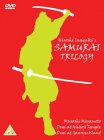![Ugetsu [4K UHD + Blu-Ray] (Criterion Collection)](/pictures/1168350.jpg) Ugetsu | Blu Ray | (19/05/2025)
from £19.99
| Saving you £N/A (N/A%)
| RRP
Ugetsu | Blu Ray | (19/05/2025)
from £19.99
| Saving you £N/A (N/A%)
| RRP By the time he made Ugetsu, Kenji Mizoguchi was already an elder statesman of Japanese cinema, fiercely revered by Akira Kurosawa and other directors of a younger generation
 The Samurai Trilogy | DVD | (30/10/2004)
from £N/A
| Saving you £N/A (N/A%)
| RRP
The Samurai Trilogy | DVD | (30/10/2004)
from £N/A
| Saving you £N/A (N/A%)
| RRP The Samurai Trilogy is based around the life of the historical character Musashi Miyamoto. Born around 1584 he perfected the technique of two sword fighting as well as developing into a considerable Zen black ink artist. Having fought his first duel at the age of thirteen he was involved in 60 other engagements before his death in 1645. Musashi Miyamoto: The first episode of the trilogy covers Miyamoto's formative years as he emerges from rural obscurity to search for fame and glory in civil war but returns home a broken man. Brought back to sanity through the love of a warm hearted girl she persuades him to place himself under the spiritual guidance of an unorthodox Buddhist priest. His methods of teaching the ways of enlightenment would make the fiercest of Zen masters seem positively gentle. Gaining in spiritual stature and insight Miyamoto is forced to choose between settling for domestic happiness or continuing his search for perfection in the art of the sword. Several versions of Miyamoto's life have been produced for cinema and television in Japan but none more prestigious than Inagaki's Samurai Trilogy. Winner of the Academy Award for Best Foreign Language Film in 1955 this first film in the trilogy was also Toho's first foray into colour. Duel At Ichijoji Temple: At first a contemptuous wanderer whose only interest is to prove his prowess against the best Japan has to offer Miyamoto is brought to understand that mastery of the sword is mastery of the self. Along the way he moves from casually committing slaughter to adopting a more compassionate and merciful view of his fellow warriors... Duel At Ganryu Island: His destiny continues to pursue him! Settling down to a life on the land in a peasant village Miyamoto is drawn into protecting the villagers against marauding bandits. And beyond this battle lies the ultimate contest with the driven and obsessive Kojuo Sasaki. The epic closes in a stunning sunset duel...
![Ugetsu Monogatari [Masters of Cinema] (Dual Format Edition) [Blu-ray]](/pictures/1113975.jpg) Ugetsu Monogatari | Blu Ray | (23/04/2012)
from £N/A
| Saving you £N/A (N/A%)
| RRP
Ugetsu Monogatari | Blu Ray | (23/04/2012)
from £N/A
| Saving you £N/A (N/A%)
| RRP Mizoguchi's Ugetsu Monogatari [Tales of the Rain and Moon, aka Ugetsu] is a highly acclaimed masterwork of Japanese cinema. Based on a pair of 18th century ghost stories by Ueda Akinari, the film's release continued Mizoguchi's introduction to the West, where it was nominated for an Oscar and won the the Venice Film Festival's Silver Lion award (for Best Direction). In 16th century Japan, amidst the pandemonium of civil war, potter Genjuro (Mori Masayuki) and samurai-aspirant Tobei (Ozawa Sakae) set out with their wives in search of wealth and military glory respectively. Two parallel tales ensue when the men are lured from their wives: Genjuro by the ghostly charm of Lady Wakasa (Kyo Machiko); Tobei by the dream of military glory. Famed for its meticulously orchestrated long takes and its subtle blending of realistic period reconstruction and lyrical supernaturalism, Ugetsu Monogatari is an intensely poetic tragedy that consistently features on polls of the best films ever made.
![Musashi Miyamoto [1955]](/pictures/1003988.jpg) Musashi Miyamoto | DVD | (21/05/2001)
from £N/A
| Saving you £N/A (N/A%)
| RRP
Musashi Miyamoto | DVD | (21/05/2001)
from £N/A
| Saving you £N/A (N/A%)
| RRP The Samurai Trilogy is based around the life of the historical character Musashi Miyamoto. Born around 1584 he perfected the technique of two sword fighting as well as developing into a considerable Zen black ink artist. Having fought his first duel at the age of thirteen he was involved in 60 other engagements before his death in 1645. Several versions of his life have been produced for cinema and television in Japan but none more prestigious than Inagaki's Samurai Trilogy. Winner of the Academy Award for Best Foreign Language Film in 1955 it was also Toho's first foray into colour. The first episode of the trilogy covers Miyamoto's formative years as he emerges from rural obscurity to search for fame and glory in civil war but returns home a broken man. Brought back to sanity through the love of a warm hearted girl she persuades him to place himself under the spiritual guidance of an unorthodox Buddhist priest. His methods of teaching the ways of enlightenment would make the fiercest of Zen masters seem positively gentle. Gaining in spiritual stature and insight Miyamoto is forced to choose between settling for domestic happiness or continuing his search for perfection in the art of the sword.
![Duel At Ichijoji Temple [1955]](/pictures/1003835.jpg) Duel At Ichijoji Temple | DVD | (20/02/2003)
from £N/A
| Saving you £N/A (N/A%)
| RRP
Duel At Ichijoji Temple | DVD | (20/02/2003)
from £N/A
| Saving you £N/A (N/A%)
| RRP The Samurai Trilogy is based around the life of the historical character Musashi Miyamoto. Born around 1584 he perfected the technique of two sword fighting as well as developing into a considerable Zen black ink artist. Having fought his first duel at the age of thirteen he was involved in 60 other engagements before his death in 1645. Several versions of his life have been produced for cinema and television in Japan but none more prestigious than Inagaki's Samurai Trilogy. Winne

Please wait. Loading...
This site uses cookies.
More details in our privacy policy